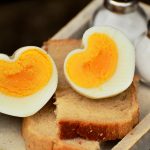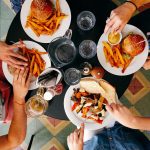Nutrition guide for women’s health: What healthy foods to eat for women diet?
Diet Tips and Nutrition Tips for Women. Nutrition guide for women’s health: What healthy foods to eat for women diet?
The Right Diet Makes You Feel and Look Great in Life
Women find it difficult to achieve a healthy diet if they’re coping with school or career demands. But, eating the right food not only boosts a woman’s energy. It also offers big support in the stages of their life. For women, a healthy diet is a solution to relieve them with their PMS. It’s capable of boosting fertility and make pregnancy easy.
Also, the symptoms of menopause would be easy to handle for women if they’re healthy. The bones become much stronger, and it opens their beauty within. Despite your situation or age, a healthy diet meal gives you the best look you deserve. You feel good all the time that leads to a happy life. The result: every stage of your life is meaningful.

How do women’s nutritional needs differ from men’s?
During childhood, the dietary needs of boys and girls are the same. But, during the stage of puberty, the hormonal changes in the body prompt our diets to change. So, as women age, they need to cope with diet needs to stay healthy. The development of nutritional needs is a big factor. Hence, it would be an advantage if women look for their eating habits.
Women don’t need to have high calories than men. But, they need the right number of vitamins and minerals. These are essential to make menstruation and childbearing easy. If women don’t have these, a high risk of anemia and weak bones are the result. As women age, the need for vitamin D, calcium, iron, magnesium,etc. are important. It builds a healthy and happy lifestyle for women.
Why many women fall short of the nutritional guidelines
Being women, we often ignore our diet needs. A few of the reasons are family or work. If we don’t meet these needs, the result is poor health. It might result in low energy, a cranky feeling or being hungry too. These are not only the issue for women. Some studies also neglect the needs of women about nutrition. Most research focuses on male subjects whose hormones are stable.
Often, the test results are irrelevant for women. It leads to false information about the right needs women want. These scenarios add to further downfalls in a woman’s nutritional needs.
It’s essential to pattern your diet needs from the things you eat. A diet plan works for a woman, but it doesn’t suit other’s needs. Whether you’re facing PMS or menopause, it’s better to consider the healthy diet that your body accepts. The tips involve in your diet are a big help to live a healthy lifestyle in all the stages of your life. It can also keep you from ignoring your health needs.
Why aren’t supplements enough for women?
From the past, women came up with things that fill up their health needs. The great examples of these are supplements and vitamins. These prove to be useful, but it affects the diet plans of women as well. Hence, some women resort to eating unhealthy diets. The best way you can do is eat foods rich in vitamins and minerals.
The examples are vegetables and fruits. These have the right calories and enough nutrients. You avoid foods having high-fat content and sugar. It’s best to live on the right plan to achieve a healthy success.
Calcium is essential for strong bones
Women need calcium to keep their teeth and bones stronger. During old age, your bones enough calcium to avoid osteoporosis. It helps in maintaining the heart’s rhythm and assures the nervous system works. Women lacking with calcium become irritable or fearful. There are certain cases insomnia and depression arises.
So, if you have calcium in your diet, you can avoid weak bones and live a happy life. Since women have greater risks than men to have osteoporosis, calcium is important. Also, don’t forget to eat foods having Vitamin D and Magnesium. These are important in supporting your bones.
Exercise for Healthy Bones
Doing an exercise routine is effective to make bones healthy. But, you need to value your lifestyle to make this work. Women who drink or smoke too much might have osteoporosis. It’s best to add exercise to your health regimen. A few of the best exercises you can do are dancing or walking. You can also do resistance training. It involves using free weights, machines and elastic bands. These help you prevent bone loss in old age.
How much calcium, magnesium, and vitamin D do you need?
Calcium: Women ages 19 to 50 years old needs to take 1,000 mg/day. Meanwhile, women who age 50 should take 1,200 m/g of calcium per day. The best sources of calcium are tofu, grains, cabbage and more.
Magnesium: The absorption of calcium from the blood to the bones depends on magnesium. The USDA recommends an allowance of 320 to 400 mg/day. You can find this from summer squash, cucumber, celery and green beans.
Vitamin D: Having Vitamin D is also essential in the right metabolism of calcium. It would be best to have 600 UI of this vitamin per day. You have a good source of this from salmon, cod, eggs,and milk.
| Good food sources of calcium | |
| Food | Milligrams (mg) per serving |
| Yogurt, plain, low fat, 8 ounces | 415 |
| Mozzarella, part skim, 1.5 ounces | 333 |
| Cheddar cheese, 1.5 ounces | 307 |
| Cottage cheese, (1% milk fat), 8 ounces | 138 |
| Cheese, cream, regular, 1 tablespoon | 14 |
| Milk, nonfat, 8 ounces | 299 |
| Milk, reduced-fat (2% milk fat), 8 ounces | 293 |
| Milk, whole (3.25% milk fat), 8 ounces | 276 |
| Soymilk, calcium-fortified, 8 ounces | 299 |
| Ready-to-eat cereal, calcium-fortified, 1 cup | 100-1,000 |
| Sardines, canned in oil, with bones, 3 ounces | 325 |
| Salmon, pink, canned, solids with bone, 3 ounces | 181 |
| Tofu, firm, made with calcium sulfate, 1/2 cup | 253 |
| Tofu, soft, made with calcium sulfate, 1/2 cup | 138 |
| Turnip greens, fresh, boiled, 1/2 cup | 99 |
| Kale, raw, chopped, 1 cup | 100 |
| Kale, fresh, cooked, 1 cup | 94 |
| Chinese cabbage, bok choy, raw, shredded, 1 cup | 74 |
| Broccoli, raw, 1/2 cup | 21 |
| Source: National Institutes of Health | |
Should you avoid dairy because of its saturated fat content?
As you can observe from the table, dairy products are the great sources of calcium. But, foods such as yogurt, cheese,and milk are rich in saturated fat. So, the USDA states that you lessen your take of dairy products. The fat intake should not be more than 10%. It gives you better health for you to enjoy your life.
Why are you not getting enough iron?
Iron is important in the creation of hemoglobin that transports oxygen to the blood. You also have good nails, skin,and hair due to iron. But, some women don’t have sufficient iron in their body. During menstruation and childbearing, women need twice the iron than men. It can result in iron deficiency or anemia in women.
Anemia results in body weakness, shortness of breath or exhausted. It can affect your mood in the form of irritability or depression.
How much iron do you need?
The U.S Food and Nutrition Board recommends 15mg of iron for women aging 14 to 18. Women should have 27 mg if pregnant. If lactating, she needs to have 10 mg. For adults ages 15 to 50, the FNB gives 18mg/each day. Pregnant women have 27 mg while lactating women, 9 mg. Meanwhile, 8mg is right for women ages 51 above.
| Good sources of iron | |
| Food | Milligrams (mg) per serving |
| Breakfast cereals, fortified with 100% iron, one serving | 18 |
| Chocolate, dark, 45%-69% cacao solids, 3 ounces | 7 |
| Oysters, eastern, cooked with moist heat, 3 ounces | 8 |
| Sardines, with bone, 3 ounces | 2 |
| Tuna, light, canned in water, 3 ounces | 1 |
| Beef liver, pan-fried, 3 ounces | 5 |
| Beef, braised bottom round, 3 ounces | 2 |
| Chicken, roasted, meat and skin, 3 ounces | 1 |
| Turkey, roasted, breast meat and skin, 3 ounces | 1 |
| White beans, canned, 1 cup | 8 |
| Lentils, boiled and drained, 1/2 cup | 3 |
| Kidney beans, canned, 1/2 cup | 2 |
| Chickpeas, boiled and drained, 1/2 cup | 2 |
| Spinach, boiled and drained, 1/2 cup | 3 |
| Tomatoes, canned, stewed, 1/2 cup | 2 |
| Broccoli, boiled and drained, 1/2 cup | 1 |
| Green peas, boiled, 1/2 cup | 1 |
| Raisins, seedless, 1/4 cup | 1 |
| Tofu, firm, 1/2 cup | 3 |
| Potato, medium, baked, including skin | 2 |
| Cashew nuts, oil roasted, 1 ounce (18 nuts) | 2 |
| Bread, whole wheat, one slice | 1 |
| Egg, large, hard boiled | 1 |
| Source: National Institutes of Health | |
The Benefits of Vitamin B9 for Pregnant Women
Vitamin B9 or Folate plays a great role to prevent congenital disabilities of children. It happens after contraception, during the 1st weeks of pregnancy. It also prevents heart disease in women and avoids the formation of cancer. So, it’s wise for women to take folate even before they get pregnant. During the old age, vitamin B9 helps in the production of estrogen. It takes place during the menopausal stage.
If you don’t have enough folate, it can affect your mood as well. You become irritable or suffer from depression. At some point, headaches and fatigue are signs of having low folate.
Essential Tips in Boosting Fertility
Women planning to enter pregnancy or want to get enough folate could do the following:
- Avoiding alcohol, caffeine, and nicotine because these can lessen your fertility.
- Eating organic foods and grass-fed or free-range meat and eggs, to stay healthy.
- Taking a prenatal supplement
You can choose from supplements such as zinc and folic acid to boost fertility. Also, there are vitamin C and E to give support to you.
- Not overlooking your partner’s diet
Most of the infertility cases are on males. The percentage is 40%. Thus, it’s better to tell your partner to eat foods rich Vitamin D, calcium, and Zinc.
How much folate do you need?
For women, including teen girls should consume 400 mcg of folic per day. For pregnant women, 600 mcg is the right amount. Meanwhile, for breastfeeding women, 500 mcg is the best.
Examples of the great sources of folate are fruits, vegetables, and nuts. You can also find this in grain products such as bread and cereals.
| Good food sources of folate and folic acid | |
| Food | Micrograms (mcg) per serving |
| Beef liver, braised, 3 ounces | 215 |
| Ground beef, 85% lean, cooked, 3 ounces | 7 |
| Chicken breast, roasted, 1/2 breast | 3 |
| Spinach, boiled, 1/2 cup | 131 |
| Asparagus, boiled, four spears | 89 |
| Brussels sprouts, frozen, boiled, 1/2 cup | 78 |
| Lettuce, romaine, shredded, 1 cup | 64 |
| Broccoli, chopped, frozen, cooked, 1/2 cup | 52 |
| Mustard greens, chopped, frozen, boiled, 1/2 cup | 52 |
| Black-eyed peas (cowpeas), boiled, 1/2 cup | 105 |
| Green peas, frozen, boiled, 1/2 cup | 47 |
| Kidney beans, canned, 1/2 cup | 46 |
| Breakfast cereals, fortified with 25% of the DV | 100 |
| Spaghetti, cooked, enriched, 1/2 cup | 83 |
| Bread, white, one slice | 43 |
| Yeast, baker’s, 1/4 teaspoon | 23 |
| Tomato juice, canned, 3/4 cup | 36 |
| Orange juice, 3/4 cup | 35 |
| Orange, fresh, one small | 23 |
| Papaya, raw, cubed, 1/2 cup | 27 |
| Banana, one medium | 24 |
| Crab, Dungeness, 3 ounces | 36 |
| Fish, halibut, cooked, 3 ounces | 12 |
| Egg, whole, hard-boiled, one large | 22 |
| Milk, 1% fat, 1 cup | 12 |
| Source: National Institutes of Health | |
Right Eating to Ease PMS Symptoms
Women are facing PMS experience fatigue, bloating, fatigue or cramp. The condition might affect their diets and their lifestyle. So, preparing the right diet is important at this stage. You have a better chance of pushing your way through PMS.
Here are the important things you would do:
Eat foods high in iron and zinc. It would be a good idea to focus on foods such as eggs, liver,and veggies. You have the assurance of easing the PMS symptoms.
Boost your calcium intake. Studies prove the importance of calcium in relieving PMS signs. You can find calcium in foods such as cheese, yogurt, green vegetables and others.
Avoid trans fats, deep-fried foods, and sugar.
Foods high in fats are inflammatory, so these triggers PMS women.
Battle bloat by cutting out salt.
If you don’t want bloat to bother you, it’s good to avoid frozen snacks. You can also refrain from eating salty foods. You do it and see the big difference it would make in your life.
Add essential fatty acids to ease cramps.
Are you familiar with Omega 3 fatty acids? Studies prove that this is essential in preventing cramps. You can also try eating fish as it helps you fight PMS symptoms.
Watch out for food sensitivities.
If you like eating wheat and dairy, you need to avoid PMS. These prove to be a few of the major causes of PMS. So, cutting your excessive eating gives you a healthy life in the end.
Cut out caffeine and alcohol.
These give you worse symptoms of PMS. Thus, you better avoid the habit of eating it often.
Consider vitamin supplements.
You might want to take supplements with vitamin E and magnesium. But, you have to remember, it would be better to still get nutrients directly from food.
Healthy Diet for Pregnant and Breastfeeding Women
Women need to have 300 calories per day to sustain a baby. But, gaining weight is normal during the pregnancy stage. Don’t worry because nursing can help you lose weight after giving birth.
Nutrition tips for a healthy pregnancy
Omega-3 fatty acids.
These are important for the neurological the baby. It also plays a great role in the infant’s early visual development. Mothers have a great chance of making breast milk because of omega 3.
These are the things you need to do: you must have two servings per week of water. Then, you add your diet salmon, sardines, and anchovies. Sardines proves to be the safest and sustainable fish you can eat. Meanwhile, seaweed is a good source for vegetarian Omega-3s.
High-quality protein is essential in a baby’s brain. It also acts to make the nervous system health. You can find quality protein from fish, dairy, and plant protein source than eating red meat.
Abstain from alcohol. Mothers who drink alcohol during pregnancy could give congenital disabilities to the baby. So, you need to prevent drinking this kind of beverage for baby’s sake.
Cut down on caffeine that proves to result in a miscarriage of the infant. It can also interfere with the process of iron absorption.
Eat smaller, more frequent meals instead of eating large ones. It would help prevent morning sickness. Also, it aids in the prevention of heartburn.
Be cautious about foods that may be harmful to pregnant women.
The foods to avoid are soft cheeses, deli meats, and fish. A few examples of white meat are albacore tuna, tilefish, and king of the mackerel. You need to be careful because it has high mercury content.
Nutrition tips for healthy breastfeeding
Keep your caloric consumption a little higher
It aids the body in maintaining a regular milk supply.
Emphasize healthy sources of protein and calcium,
These nutrients are in demand in the lactation stage. Nursing women should have 20 grams of protein per day. It gives them the edge to help in milk production.
Take prenatal vitamin supplements,
Taking supplements are helpful during breastfeeding. But, it depends on your doctor if supplements are advisable for you.
Avoid alcohol, caffeine, and nicotine.
These have a great effect on the baby and the mother as well.
If your baby has an allergic reaction, you need to change or adjust your diet. A few examples of allergens include eggs, fish or citrus. For milk allergy from a cow, you can get calcium from foods such as kale, or sardines.
Keeping The Right Diet to Be Comfortable During Menopause
Boost calcium intake
You also need to boost with magnesium and vitamin D to support healthy bones.
Limit wine, sugar, white flour products, and coffee
It helps in easing hot flashes in women.
Eat more good fats.
Both omega-6 and omega-3 are important fatty acids that boost hormone development. It also offers you a healthy glowing skin.
Try flaxseed for hot flashes.
It helps normalize the hormone levels in your body. Also, it manages hot flashes in women. You add 1- 2 tablespoons of flaxseed in your diet. You can sprinkle it on salads or dishes.
Eat more soy.
Soy products have phytoestrogens. These are plant estrogens the same with estrogen from the body. Studies states soy is effective in managing menopausal symptoms.
Photo sources: pixabay.com


